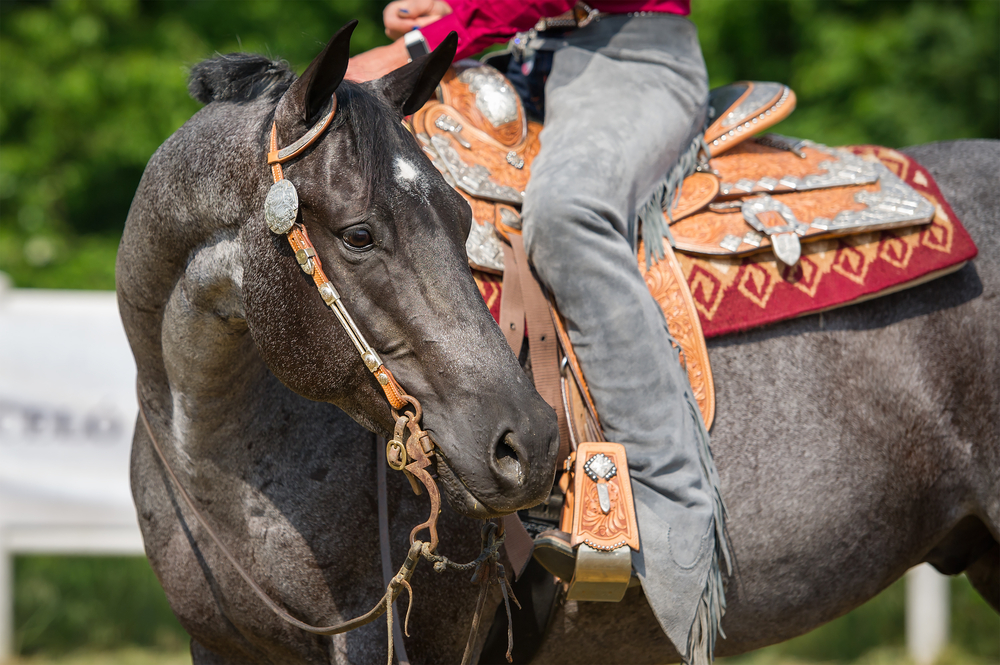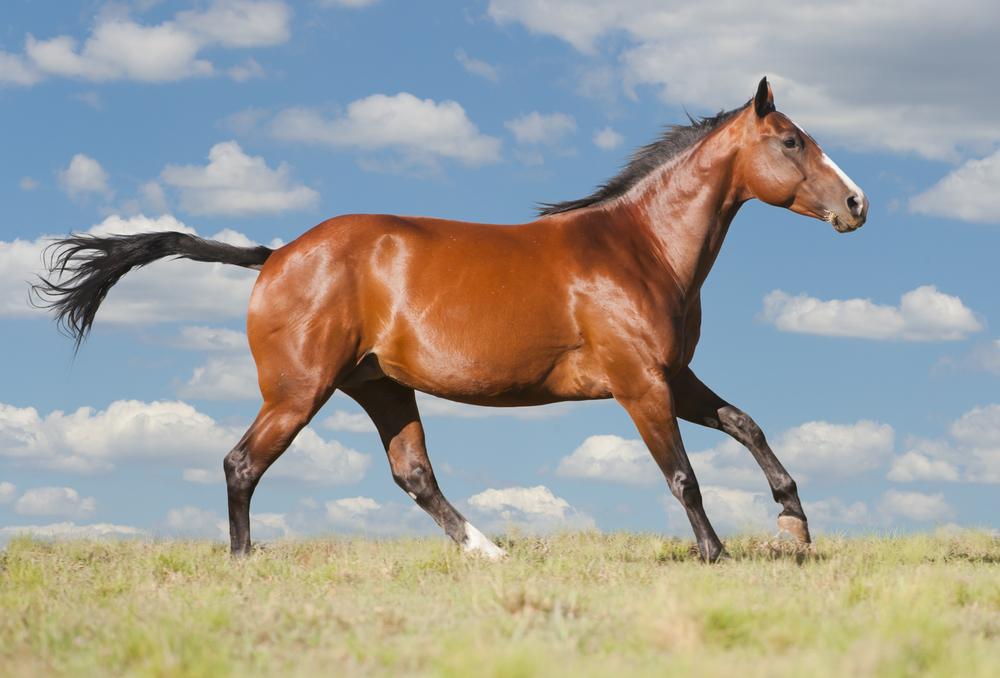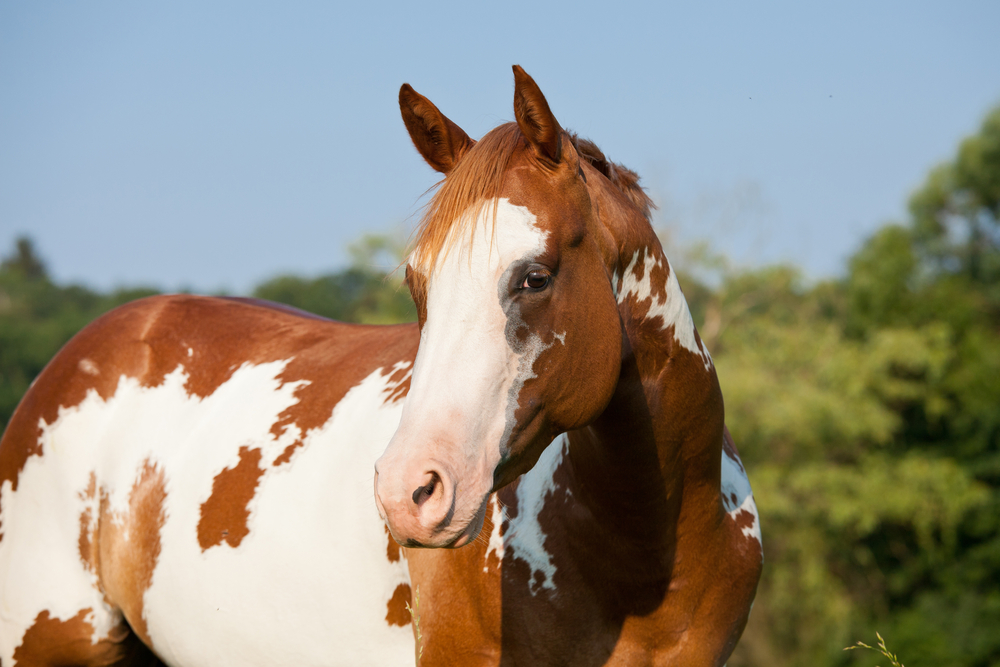
“Horses for courses” is a British proverb about people. At the proverb’s root is the understanding that you use the breed of horse best suited for the discipline or activity at hand. For example, a pampered Grand Prix showjumper would be a terrible choice for cutting or team penning. So what are the best breeds for Western riding?
The best horse breeds for Western riding include the American Quarter Horse, American Paint, Appaloosa, Arabian, and Morgan. The best all-around Western breed is the American Quarter Horse. A good stock horse with “cow sense” is best for certain events, such as cutting or team penning.
Western riding disciplines include barrel racing, cutting, endurance, reining, gymkhana, trail riding, team penning, and Western pleasure. Each event highlights different strengths. Barrel racing is all about speed and agility, where endurance racing requires staying power. It all depends on the horse, it’s training, and the event.
American Quarter Horse: Best for Western Riding
There is no denying it; American Quarter Horses dominate Western riding sports. Western riding disciplines are practically designed for the Quarter’s muscular body, deep chest, and powerful haunches. While they are not always the top choice for a sport, such as endurance, the Quarter will still be found amongst the competition.
However, there are many wonderful Western riding breeds, many that will not be mentioned in this article. Some of these other breeds might suit your personality and preferences better than the Quarter. Also, any horse, even a non-pure bred, with the proper training, attributes, and temperament can still do brilliantly in Western riding.
The best horse breed out there for your Western discipline of choice is the horse you love to ride.
Best Barrel Racing Horse Breeds
Barrel racing is a women’s rodeo event that began in 1948. Competitors enter the area at full speed and make a cloverleaf pattern around barrels that have been placed in a triangular shape. The turns are tight, with quick blasts between barrels, in addition to the sprints and the start and finish of the race.
A horse’s speed is crucial, along with coordination, balance, agility, and a strong hind end. A horse needs sure footing, which means good feet. Short cannon bones, low hocks, short toplines, and low hocks are also desirable attributes for a barrel racing horse.
Common horse breeds used in the sport are:
The most popular breed for barrel racing is the American Quarter Horse. This is unsurprising since they are one of the fastest horses on earth. However, Arabians and Thoroughbreds, not commonly thought of as a Western riding breed, are rapidly rising in popularity in the sport.
Not on the list is the Appendix Quarter Horse. These are American Quarter Horses bred with Thoroughbreds. The registry of Appendix Quarter Horses began in 1949, combining the quick speed of a Quarter with the longer distance speed of a Thoroughbred. As a result, they are easier keepers than your typical Thoroughbred.
Best Competitive Trail Riding Horse Breeds
Competitive trail riding (CTR) is a long-distance trail race, but the distances tend to be shorter than found in endurance racing. CTR, while timed, is also a judged race. Points are earned for safety, horse management, and teamwork between rider and horse. Due to the point system, the fastest horse in the race is not always the winner.
There are no breed restrictions for CTR. Due to the shorter distances, horses that struggle with the length of endurance racing might be perfect for CTR. Attributes to look out for are sure-footedness, a calm temperament, stamina, and, to a degree, speed.
Arabians are an obvious choice, known for their endurance. Mustangs, who have a history of roaming wild across America, are also popular. But this sport is also where gaited horses have an advantage, providing the rider’s comfort and sure-footedness.
Popular naturally gaited breeds for CTR are the Islandic, Missouri Fox Trotters, Paso Fino, and Tennessee Walking Horse. While these breeds do not have the speed of the Arabian, their temperaments loan themselves to earning points in the judge portion of the competition.
While American Quarter Horses are used in CTR and endurance, their speed and strength suit shorter distances than marathons. But like most things in horse riding, it all comes down to the individual horse. Given the Quarter Horse’s hardy nature and great temperament, they can do brilliantly in CTR.

Best Cutting Horse Breeds
Cutting is a Western riding discipline for men and women where the horse and rider are given two and half minutes to “cut” three animals out of a herd and keep them from rejoining. Riders are scored on points that range between 60 and 80. Riders will lose points for various things, such as a cow running back to the herd.
It is vital in cutting to use horses with “cow sense” or “cowiness.” These horses are bred to be around cattle and have an almost intuitive sense of how cattle behave and move. Also, temperament and bomb proofing are essential, as a spooky horse cannot keep their head around the chaos of a herd.
Horses need to be quick, with a solid hind end for bursts of speed and agility, and able to stop on a dime. Because of this, horses with a shorter back usually do better than one with a longer back.
Common horse breeds used in the sport are:
Around 96% of horses used in cutting are American Quarter Horses. Thus, even when looking at the American Quarter Horse, you want one that comes from stock breeding rather than hunter/racing.
Morgans are often overlooked. However, as the original stock horse of the United States, they are ideal for keeping their head in the sport of cutting. But once again, Arabians sneak in there, thanks to their agility. However, one needs to ensure that they have the right temperament to handle the dynamic work around cattle.
Best Endurance Horse Breeds
Endurance riding is the marathon of horse riding sports. While there are similarities to competitive trail riding (CTR), endurance riding is much more of a race, while the winner of CTR is not necessarily the first horse to cross the finish line.
Endurance riding tends to have much longer races than CTR, too. Because of the extra miles, endurance horses tend to be far more specialized in the sport than a horse used in CTR.
Common horse breeds used in the sport are:
The two most popular breeds for endurance riding are the Arabian and Anglo-Arabian. These horses are bred for the stamina to do the long distances. Arabians are smaller, which makes them unsuitable for riders over a certain size. An Anglo-Arabian has height thanks to the Thoroughbred influence and thus has more carry.
That said, endurance riding can be incredibly hard on the rider’s body. Be it due to aging, injury, or disability, riders might find switching to a gaited breed, such as the Rocky Mountain Horse, will allow them to keep participating in the sport they love.
Rocky Mountain Horses are a smooth ride while having the balance, durability, and stamina required for endurance riding. They are a gentle breed, easy keepers, who tend to have a calm disposition, making them less likely to spook on a trail or around cattle.
Best Gymkhana Horse Breeds
Gymkhana is precisely what the Anglo-Indian word means: games on horseback. While there the sport is open to all ages, these events are typically dominated by children. There generally is a wide variety of competitions typically offered under the umbrella of Gymkhana. But they often resemble an obstacle course.
A horse’s temperament is paramount in this sport and needs to be calm and patient. Thus, a young horse is probably not suited to these games. On the other hand, the horse should be athletic, quick, and willing to take on unfamiliar challenges.
Common horse breeds used in the sport are:
Pony of the Americas (POA) is a fantastic breed for younger Western riders. This athletic breed has roots in the Appaloosa, an excellent choice for riders too big for a POA. They are a quiet and willing breed, which makes them so perfect for children. Their medium size gives them longevity with an ever-growing child, too.
Best Reining Horse Breeds
Reining is a Western riding discipline that shows of ranch skills of a horse in the confines of an arena. The sport has evolved into an art form of its own, its closest neighbor being dressage. The horses spin, stop on a dime, back up, and make figures of eight with little contact on the bit.
The sport requires horses with incredible athleticism, coordination, balance, agility, and strength. They must have a strong back, hindquarters, and hocks. Rider and horse are required to work together, with the rider keeping fairly still. Reining requires a careful training program, as it is easy to overwork a horse and cause injury.
Common horse breeds used in the sport are:
Reining began as a sport in 1949, first recognized by the American Quarter Horse Association. Thus, it comes as no surprise that it is the Quarters that dominate the discipline. All the strengths of a Quarter are showcased in this sport.
The next best bets are an American Paint or Appaloosas. But some outsiders are doing great things in reigning. Morgans, for example, are routinely overshadowed by the Quarter, but they’re holding their own in reigning, too.

Best Team Penning Horse Breeds
Penning requires teams of three riders to separate a specific animal from the herd, usually identified by its number, and guide it to a pen. It must be accomplished in under sixty seconds in a manner that is considered humane. Thus, the sport not only requires teamwork between members but also between rider and horse.
Horses used in competition not only have to be strong, quick, and incredibly athletic but also have to have a deep “cow sense” or “cowiness.” As mentioned in cutting, this is an innate understanding of how cows and their herds move. A good cattle horse can anticipate how cattle are going to react before they move.
It almost goes without saying that any animal or rider in team penning needs to be bomb-proof. Riders and their horses need to stay calm and think clearly and rationally amongst the chaos of the herd.
Common horse breeds used in the sport are:
Unsurprisingly, the American Quarter Horse is the favorite in this sport. This discipline showcases this breeds’ strengths. However, Morgans and Paints are also well known for their work and cattle and share some Quarter features.
While not common in Western riding, the French Camargue ponies have a cow sense that even earns respect from Quarter Horse fans. Camargue are one of the oldest breeds in the world, well versed in working with cattle. A hardy breed with agility and stamina, they can be brilliant at cutting or team penning. The trick is finding a Camargue in your area.
Best Western Pleasure Horse Breeds
Western pleasure is a performance of three gaits: walk, jog, and lope. It sounds simple, but it is incredibly technical, demanding perfection in the three elements. Riders are aiming to have their horses in correct formation and at the best speed for each gait.
The sport is not as hard on the horse’s body as reigning, nor require the same agility or athleticism. However, to achieve the perfection of gait there needs to be a stable frame, top-notch conditioning, innate grace, and a brilliant temperament. In addition, the training requires patience and repetition to achieve such smooth precision in the movement.
Common horse breeds used in the sport are:
Saddlebreds and Tennessee Walking Horses look elegant at this sport. Quarters and Paints are popular too, partly because they are already so popular in the other Western riding disciplines.
Above all others in Western riding, this is the sport where the breed is a side issue. You want a perfect build, movement, and wiliness to work without getting fed up with the repetitive training. If there is a Clydesdale in your life that moves with the grace and precision of a ballet dancer, then that’s the perfect Western pleasure horse for you.
Conclusion
While the American Quarter Horse dominates Western riding, it is not the only breed that can excel in Western disciplines. When looking at horses, think about what the sport you enjoy demands and your own requirements. If a horse has the right attributes for the discipline and your desires, its breed isn’t what matters.
Sources
- https://horseracingsense.com/what-is-the-best-horse-for-barrel-racing/
- https://horseandrider.com/training/how-to-select-a-reining-prospect
- https://horsemanshipworld.com/the-ultimate-guide-to-what-horse-gymkhana-is/
- https://www.horseillustrated.com/what-is-the-best-horse-for-riding
- https://www.horsejournals.com/riding-training/western/western-pleasure/ideal-western-pleasure-horse
